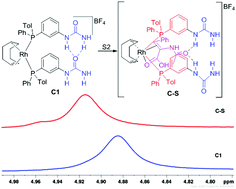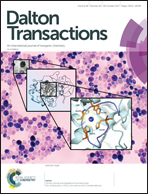Self-assembly of P-chiral supramolecular phosphines on rhodium and direct evidence for Rh-catalyst-substrate interactions†
Abstract
Supramolecular phosphine-derived catalysts are known to provide high enantioselectivity in asymmetric transformations such as hydrogenation, but direct evidence unravelling the role of secondary interactions is largely missing. As a representative case study, the role of hydrogen bonding in asymmetric hydrogenation catalysed by p-chiral supramolecular phosphines is investigated. To establish the nature of hydrogen bonding in the self-assembled Rh-complex, NMR experiments were performed at different concentrations and temperatures. It was found that with increasing concentration of 1-(3-(phenyl(o-tolyl)phosphanyl)phenyl)urea ligand (L1), the NH and NH2 peaks shift downfield. This indicated the presence of intermolecular hydrogen bonding in L1. This observation was further supported by variable temperature NMR experiments wherein, with decreasing temperature, the NH and NH2 resonances of L1 shifted downfield. The downfield shift once again suggests the existence of intermolecular hydrogen bonding in L1. In contrast, the chemical shift of NH and NH2 signals did not significantly change with increasing concentration of the self-assembled Rh-complex (C1). This observation suggested the existence of intramolecular hydrogen bonding in the self-assembled complex. The concentration experiment was further corroborated by variable temperature NMR experiments. No change in the chemical shift of NH2 resonance could be detected with decreasing temperature, which corroborates the existence of intramolecular hydrogen bonding in C1. In a stoichiometric experiment, C1 was treated with hydrogenation substrate N-acetyldehydrophenylalanine (S2) and the proton NMR was recorded. The NH2 protons of the self-assembled Rh-complex were found to shift downfield, as compared to untreated parent C1. These observations indicated that there is a hydrogen bonding interaction between the Rh-complex and the substrate. To further attest this hypothesis, NH and NH2 groups were exchanged with ND and ND2 groups, respectively, and a self-assembled Rh-complex was prepared using the deuterated supramolecular phosphine ligand L1.D. When the deuterated Rh-complex (C1.D) was treated with substrate S2, the ND and ND2 resonances were found to shift downfield. Thus, the labelling experiment further authenticated the existence of catalyst–substrate interactions. The presence of this catalyst–substrate interaction could be one of the parameters that leads to high enantiomeric excess in the asymmetric hydrogenation reaction of S2.



 Please wait while we load your content...
Please wait while we load your content...